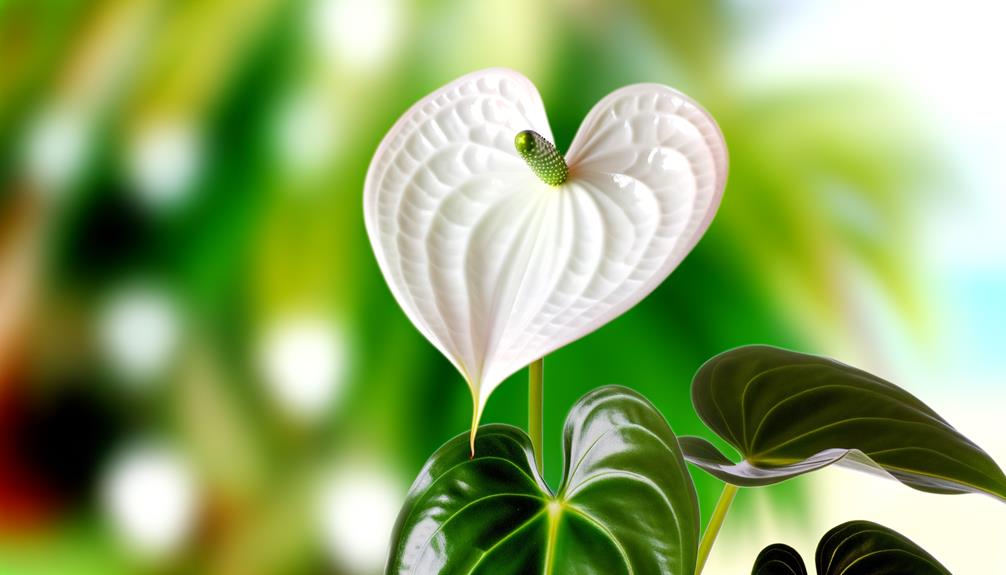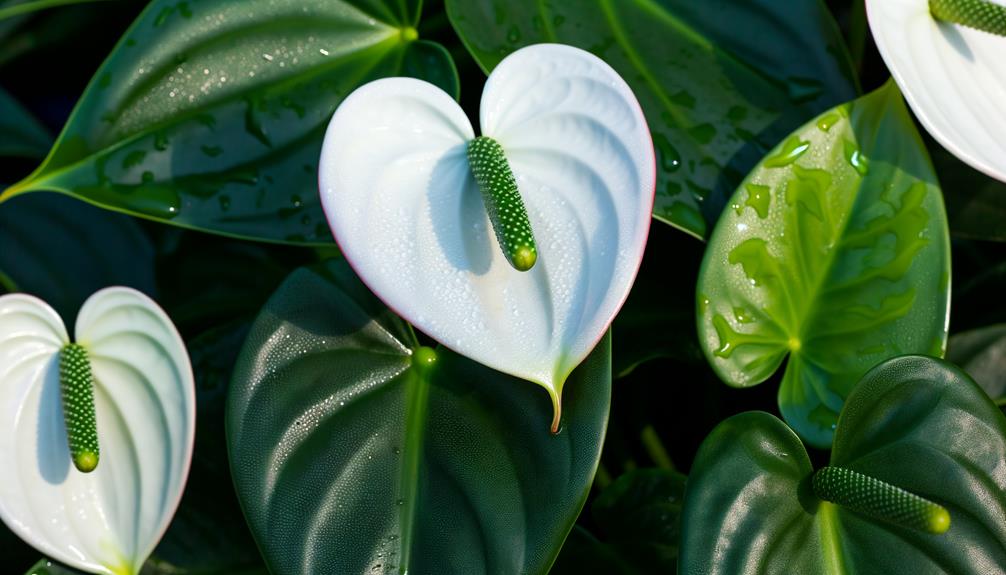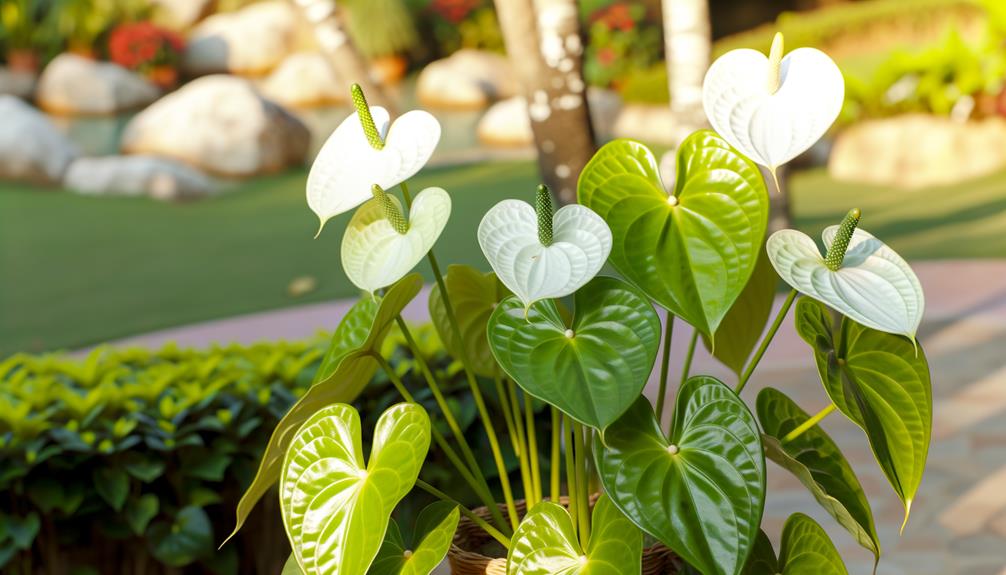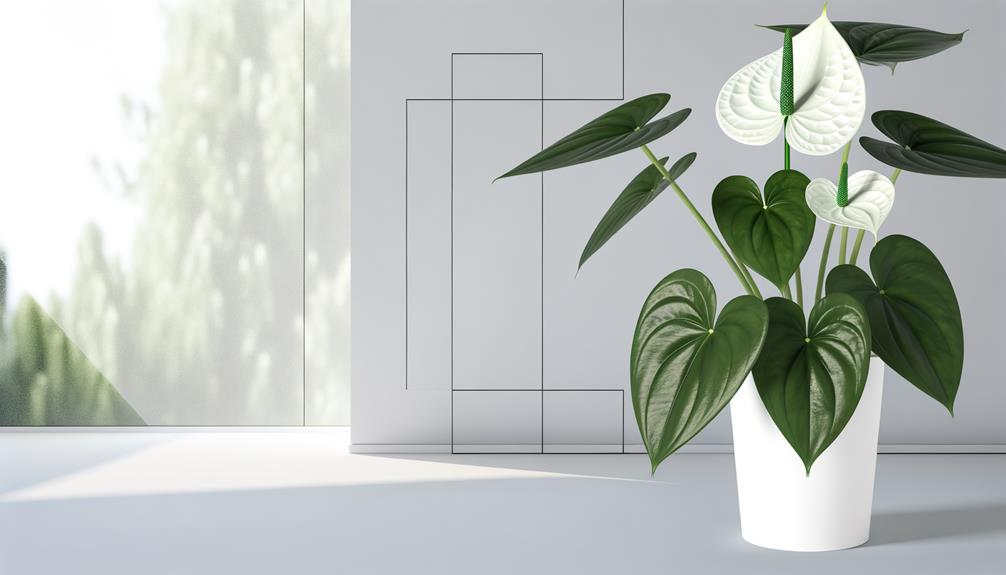Unique Features of the Anthurium White Heart: A Guide!
The Anthurium White Heart captivates with distinctive white spathes and heart-shaped leaves, both essential for attracting pollinators and indicating plant health. Its extensive root network guarantees efficient nutrient uptake and stability.
Rapid leaf development and high photosynthetic activity highlight its robust growth capabilities. This plant excels in phytoremediation, cleaning indoor air by removing formaldehyde, ammonia, and xylene.
It’s adaptable to various lighting and moisture conditions and has natural defenses against common pests. If you’re curious about its perfect fit for indoor environments and overall maintenance, there’s more to uncover about this remarkable plant.

Key Takeaways
- Distinctive white spathes that serve both aesthetic and protective functions.
- Heart-shaped leaves with smooth texture and glossy green surface for optimal light absorption.
- Extensive root network ensures strong nutrient uptake and plant stability.
- Air-purifying qualities effectively remove formaldehyde, ammonia, and xylene from the air.
- Adaptable to various lighting conditions and resilient against common pests and varying humidity levels.
Distinctive White Spathes

The distinctive white spathes of the Anthurium White Heart serve as modified leaf structures that protect the plant’s inflorescence, contributing to its unique aesthetic and biological functions.
You’ll notice how these spathes envelop the spadix, ensuring reproductive success by shielding it from environmental stressors. These spathes aren’t merely ornamental; they play an essential role in attracting pollinators through their reflective surface and subtle fragrance.
When you examine the spathes closely, you’ll see their smooth texture and uniform coloration, which indicate the plant’s health. Additionally, the spathes’ structural integrity helps them last longer, providing continuous protection.
Understanding these functions allows you to appreciate the Anthurium White Heart’s evolutionary adaptations and its seamless blend of form and function.
Heart-Shaped Leaves
You’ll notice the Anthurium White Heart’s heart-shaped leaves exhibit distinct vein patterns that contribute to their structural integrity.
The smooth leaf texture enhances the plant’s overall aesthetic while ensuring efficient photosynthesis.
Additionally, the glossy green surface reflects light, optimizing energy absorption and giving the plant a vibrant appearance.
Distinct Vein Patterns
Anthurium White Heart leaves display distinct vein patterns that enhance their heart-shaped appearance, showcasing an intricate network of primary and secondary veins.
You’ll notice the primary veins radiate from the central midrib, creating a symmetrical, fan-like arrangement. Secondary veins branch off with meticulous precision, forming a lattice that supports the leaf’s structure.
This vascular architecture ensures optimal nutrient and water distribution, crucial for the plant’s physiological functions. These veins not only strengthen the leaf’s sturdiness but also contribute to its aesthetic appeal, presenting a visually striking contrast against the leaf’s green backdrop.
Smooth Leaf Texture
With a velvety exterior, the heart-shaped foliage of Anthurium White Heart displays a silky feel that minimizes water loss and improves light absorption.
This silkiness arises from a specialized cuticle layer, reducing transpiration by forming a barrier against excessive moisture loss. The texture also facilitates ideal light capture, crucial for photosynthesis.
By reducing surface irregularities, the leaves maximize the effectiveness of photon capture, promoting strong growth.
You’ll notice the tactile charm; the leaves’ outer layer not only feels gentle but also plays a functional role in the plant’s physiology.
This unique adaptation ensures the Anthurium White Heart flourishes in different environments, preserving its lush appearance.
Understanding this characteristic highlights the plant’s resilience and enriches your admiration for its intricate design.
Glossy Green Surface
The glossy green surface of the heart-shaped leaves optimizes photosynthetic efficiency by reflecting and refracting light to penetrate deeper into the leaf tissue. This specialized surface is key to the Anthurium White Heart’s robust growth and vibrant health.
When you examine these leaves closely, you’ll notice the following:
- Light Utilization: The glossiness increases the leaf’s ability to capture more light, maximizing the photosynthetic rate.
- Water Retention: The smooth, waxy texture aids in minimizing water loss, essential for maintaining cellular turgidity.
- Pest Resistance: The reflective surface can deter herbivorous insects, reducing damage and promoting longevity.
Robust Growth

You’ll notice that Anthurium White Heart displays strong growth characterized by a robust root system and quick leaf development.
The extensive root network guarantees efficient nutrient uptake and stability, enabling vigorous overall growth.
Meanwhile, the rapid emergence of new leaves indicates a healthy rate of photosynthesis and cellular division.
Strong Root System
Among its many admirable qualities, Anthurium White Heart’s strong growth can be largely attributed to its robust root system, which ensures effective nutrient uptake and stability.
This unique feature demonstrates that:
- Nutrient Uptake: The extensive root network maximizes contact with soil particles, facilitating optimal absorption of essential minerals.
- Stability: Strong roots provide structural support, anchoring the plant securely and enabling it to withstand external pressures.
- Water Management: Effective water absorption and retention are crucial, especially in changing moisture conditions.
You’ll notice that these characteristics create an environment favorable for vigorous growth and resilience. The complexity of the root system showcases the plant’s evolutionary adaptation, making it an outstanding example of botanical engineering.
Your efforts in cultivation are rewarded with a flourishing Anthurium White Heart, reflecting the strength of its foundation.
Rapid Leaf Development
Through meticulous observation, you’ll notice that Anthurium White Heart exhibits rapid leaf development, a proof of its robust growth capabilities.
The high rate of photosynthetic activity in its chlorophyll-rich leaves accelerates cellular division and expansion.
You’ll also observe that the meristematic tissue at the leaf base remains highly active, consistently producing new cells.
This process results in a remarkably short lag phase between leaf initiation and full leaf expansion.
Air-Purifying Qualities
The Anthurium White Heart demonstrates significant air-purifying capabilities, effectively removing common indoor pollutants like formaldehyde, ammonia, and xylene from the environment.
You’ll find that it enhances air quality through phytoremediation, a process where plants absorb, sequester, and metabolize harmful substances.
Here’s a deeper look at its air-purifying qualities:
- Formaldehyde Removal: The plant’s large leaves facilitate the absorption and breakdown of formaldehyde, a common volatile organic compound found in household items.
- Ammonia Absorption: It efficiently absorbs ammonia, often emitted from cleaning products, reducing its concentration in the air.
- Xylene Filtration: By incorporating xylene into its metabolic processes, the Anthurium White Heart reduces this harmful compound, often found in paints and adhesives.
These features make it indispensable for maintaining a healthier indoor environment.
Low Maintenance

You’ll appreciate the Anthurium White Heart’s low maintenance needs, making it an ideal choice for both novice and experienced plant enthusiasts. This epiphytic species thrives on minimal intervention.
Watering requirements are straightforward: maintain moderately moist soil, watering only when the top inch feels dry. Its nutrient demands are minimal; a balanced liquid fertilizer applied bi-monthly suffices.
The Anthurium White Heart exhibits robust resistance to common pests like aphids and spider mites, reducing the need for frequent pest control measures. Additionally, the plant’s tolerance to low light conditions eliminates the necessity for constant repositioning.
With these simplified care protocols, you can enjoy its stunning aesthetic without the burden of intricate upkeep, fostering a seamless addition to your botanical collection.
Ideal Indoor Plant
Anthurium White Heart stands out as an exceptional choice for indoor environments due to its adaptability to varying light conditions and resilience against common household pests.
You’ll find it thrives in both low and bright indirect light, making it versatile for different room settings. Its robust foliage is inherently pest-resistant, minimizing the need for chemical interventions.
Consider the following attributes:
- Light Tolerance: Flourishes in low to medium light, reducing the need for specific placement.
- Pest Resistance: Natural defenses against common pests such as spider mites and aphids enhance longevity.
- Humidity Adaptability: Maintains peak health in varying humidity levels, from typical indoor air to more humid conditions.
These characteristics make the Anthurium White Heart a reliable and low-maintenance indoor companion.
Conclusion
In choosing the Anthurium White Heart, you’re not just picking a plant; you’re selecting a botanical wonder that could outshine the sun. Its unique white spathes, heart-shaped leaves, and strong growth make it an unmatched addition to your indoor space.
Beyond its visual appeal, its air-purifying qualities and low maintenance needs guarantee it thrives with minimal effort. Embrace this extraordinary plant, and enhance your environment both scientifically and aesthetically.






